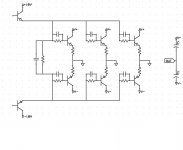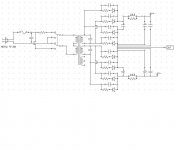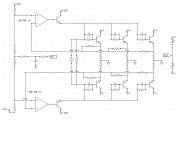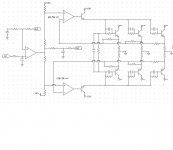Now if I use the MJL1302/3281 they actually begin to have Ft and Hfe fall off around 5 amps of collector current. The MJL4281/4302 do the same at slightly less current.
Then use a triple and Hfe falloff be damned.
What kind of driver should we look at?
Same type as the output (with the triple). Then you can use your favorite fragile low Cob device as a predriver.
What kind of driver should we look at?
Beta enhanced?
I guess that would be Darlington.
you can buy the kW Behringer, QSC PA for less than a hobbyist can buy their power supply parts, case, heatsinks for in single qty
http://www.google.com/search?tbm=sh....12...0.0.0.513019.0.0.0.0.0.0.0.0..0.0...0.0.
you may want to look at their schematics as well - I believe the highest power are Class G/H "rail switching"
maybe they just need tweaking/POOGing? - add a feedforward error correction amp, treating them as the "current dumping" stage?
http://www.google.com/search?tbm=sh....12...0.0.0.513019.0.0.0.0.0.0.0.0..0.0...0.0.
you may want to look at their schematics as well - I believe the highest power are Class G/H "rail switching"
maybe they just need tweaking/POOGing? - add a feedforward error correction amp, treating them as the "current dumping" stage?
Last edited:
The Behringer is a 550 watt stereo amplifier. Not exactly a real monster. QSC does however build some real monsters, but not for $300!
More real stuff tomorrow.
More real stuff tomorrow.
At such high powers using class AB amps mandate scrupulous
examination of the output stage capabilities in respect of the
available devices.
As pointed by some , the usual double EF is beta limited,
while a triple EF is hardly stable.
The better path is to use power mosfets since gates capacitances
current requirements are far easier to deal with , not counting
a better phase response that allow more energic feedback
to compensate for the lower linearity of powermos...
examination of the output stage capabilities in respect of the
available devices.
As pointed by some , the usual double EF is beta limited,
while a triple EF is hardly stable.
The better path is to use power mosfets since gates capacitances
current requirements are far easier to deal with , not counting
a better phase response that allow more energic feedback
to compensate for the lower linearity of powermos...
Let us look at a possible output stage that is easy to drive!
Yeah, that one's easy to drive, but now you've got to buy two transformers. Unless of course, you're only building a mono subwoofer amp.
Two of the issues to address are the type and manor of feedback and the influence of noise on BJTs.
The best way to address the noise of the power supply is to keep noisy circuits isolated from cleaner ones.
You can use an extra winding on the transformer to power the rest of the circuit or you can use more transformers. You would need to wind 60 turns on atypical toroid to get the extra winding. Not really a big deal.
This is a maximum power from the AC outlet design so of course it is a mono block. You really don't want to drive a tweeter with more than 1000 watts. Although I do have a system that did.
The best way to address the noise of the power supply is to keep noisy circuits isolated from cleaner ones.
You can use an extra winding on the transformer to power the rest of the circuit or you can use more transformers. You would need to wind 60 turns on atypical toroid to get the extra winding. Not really a big deal.
This is a maximum power from the AC outlet design so of course it is a mono block. You really don't want to drive a tweeter with more than 1000 watts. Although I do have a system that did.
The input line cap should be after the switch! That cap should be a 10 uf motor run type. See McMaster-Carr
Part # 7602K27
Now who can tell me why the DPDT switch for power?
Part # 7602K27
Now who can tell me why the DPDT switch for power?
Well so far the few suggestions have been reasonably good, but the next issue is how to bias the output stage. The design I have in mind not only provides accurate bias, it also reduces output stage distortion and DC offset.
Any guesses how this is done?
Any guesses how this is done?
I generally agree with you, but what you mean with a more energic feedback? in a classic op-amp design, I mean, what would you do, dcrease the Rf/Ri ratio?. Or just increase the OLG?At such high powers using class AB amps mandate scrupulous
examination of the output stage capabilities in respect of the
available devices.
As pointed by some , the usual double EF is beta limited,
while a triple EF is hardly stable.
The better path is to use power mosfets since gates capacitances
current requirements are far easier to deal with , not counting
a better phase response that allow more energic feedback
to compensate for the lower linearity of powermos...
Class H meets the needs for high power 'low cost' ?. I think I have one I was playing around with in my basement. Prof Leach also has one.
I generally agree with you, but what you mean with a more energic feedback? in a classic op-amp design, I mean, what would you do, dcrease the Rf/Ri ratio?. Or just increase the OLG?
Greater OLG but also higher unity loop gain frequency ,
that is practicaly , lower compensation caps than with
an output power stage using BJTs.
In the US the maximum for AC plugs with parallel prongs is 15A. For continuous current draw, the maximum is 80% of that or 12A. A 20A circuit requires a special outlet that will accept a plug with one prong (not sure which one) turned 90 degrees. It is a code violation to install 15A outlets on a 20A circuit.
Most amps rated more than 1000W will not produce that much power continuously. They are rated to produce pulses of power.
(snip)
For continuous current draw
"Continuous" means a period of 3 hours or more.
It is a code violation to install 15A outlets on a 20A circuit.
Incorrect. One or more dual 15 Amp receptacles are permitted on a 20 Amp circuit. The important part of the rule is:
If you install 15 Amp receptacles on an a 20 Amp circuit, you must install two or more of them.
A speaker is nowhere close to a motor drive. Even a subwoofer needs a clean low thd signal to sound good, something only a class A/AB amp can do.
Class D in my opinion has no future, and no its not getting any better, its still today the same crap it was back in the 70's when it was first tried.
Who remembers those philips or whatever class d modules from the 70's that were notorious for failing.

You know what else is going nowhere is this talking picture-box thing everyone has in their living room.
- Status
- Not open for further replies.
- Home
- Amplifiers
- Solid State
- DIY Max Power Low Cost Amplifier Design



